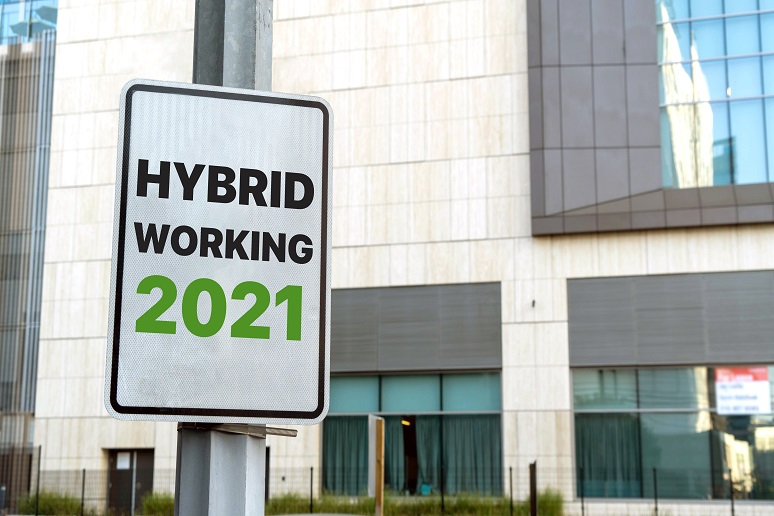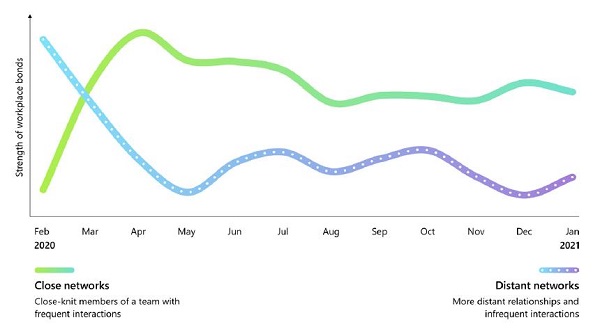I should have seen it coming. You need three occurrences of something to call it a trend, and with hybrid work, we’re well past that threshold. My last two No Jitter posts have looked at each side of the hybrid coin —
work from home (WFH) and
return to office (RTO) — and since then, I’ve explored a few other facets of hybrid work on my
Watch This Space podcast. A lot is going on here, and I was too slow putting on my who-wants-to-be-an-Internet-millionaire hat — all the good
www.hybridwork domains are now taken, dang.
Switching back to my analyst hat, all the vendors are talking about it now, and while we have the technology to make the hybrid model work, it’s complicated. This isn’t like re-tooling the shop floor of an auto plant — not every workplace task can be automated, and not all productivity inputs can be measured. The great thing about automation is having continuous workflows that need little attention once up and running, but workers have lives to live, and each is coping with the pandemic in their own way.
Be Careful What You Wish For
On paper, the hybrid model sounds like — and is — the best way to balance many needs for what we call work in the current environment. Throughout 2020, the pendulum swung far to normalize WFH, and now we know that experiment has worked well for some, and not so well for others.
Looking ahead to a post-pandemic world, enterprises and vendors are now in RTO mode, doing all kinds of things to make this work, and once that’s in place, the hybrid model should bear fruit. We’re all rooting for a happy medium with WFH and RTO, but to have success with this new model, there are some important lessons from 2020 worth noting.
Along those lines, research studies are coming out now that demonstrate what we did and didn’t do right in 2020. I’m going to share highlights from two new studies that support my position about the complications of hybrid work. First is a study from
Otter.ai, one of the leading vendors offering AI-driven real-time transcription, followed by the 2021 edition of
Microsoft’s Work Trend Index.
Otter.ai Study — Takeaway #1: WFH Is a Mixed Bag
As the following data points illustrate, the experiences and expectations around home-based working are all over the map:
- 39% of home-based workers are doing so on a full-time basis, and believe that will continue indefinitely
- An additional 36% of the same think they will return to office-based work, at least partially
- 24% are working currently in the office at least some of the time
- 14% want to return to the office full-time, when it’s safe to do so
- 20% never want to return to the office
Other studies show a similar profile, so the findings aren’t a surprise. However, this data set makes a strong case for the hybrid model, as one mode of working clearly won’t make everybody happy. The remote working trend has been building for years, and the pandemic accelerated things, albeit faster than most of us would have liked. And that’s where challenges arise.
Otter.ai Study — Takeaway #2: More Meetings Doesn’t Mean More Productivity
We know that not everyone is cut out to work from home, but even for those who prefer it, the rapid cutover from office to home gave rise to problems that persist. Without a playbook for doing WFH at scale, everyone learned as they went, but with tools natively designed for the office. In a normal office environment, video meetings are merely one mode for both communicating and collaborating. In many cases, it’s the last resort, especially when the people you need to interact with are in the same office.
Flip the script over to WFH, and video meetings seem to have become the first resort, and for some, the only resort for working with others. It wouldn’t occur to a Millennial to just pick up the phone and call a co-worker or set up a conference call for the team. For better or worse, the Zoom effect has conditioned us to use video for almost everything, and voice calls seem so quaint now. Until the video vendors raise their prices, this behavior may be hard to change — unless other factors emerge, and Otter.ai’s research indicates that’s already happening.
- 42% have experienced “Zoom fatigue” since they’ve been working from home
- 20% say it’s getting worse
- 41% said the impact has led to “poor productivity”
- 27% said all these meetings mean they cannot leave home due to work
- 22% reported an inability to sleep properly
We all know what Zoom fatigue feels like. This data is interesting for demonstrating how the impact goes beyond work and can also be a drag on our personal lives. When video meetings become the go-to option for almost everything, the immersive experience takes a toll at some point and can become counterproductive.
The implication that Otter.ai rightly draws is that the WFH experience needs to be re-thought. If video meetings are going to continue being the primary mode of interacting at home, workers need to learn how to run better meetings. The technology on its own is fine, but in terms of workflows, being efficient, and maintaining concentration, the human factor needs to be addressed.
We can’t overlook the value of video to provide human connection while working in isolation, however, employers need to recognize the longer-term impact of video. The novelty of video has worn off by now, to maintain productivity with WFH, but better practices are needed for running meetings. This needs to be part of the WFH playbook, and along those lines, the report provides seven recommendations.
Microsoft Study — Takeaway #1: High Productivity Comes with a High Price
Whereas Otter.ai addresses one slice of the collaboration pie, Microsoft addresses the whole pie, and that’s reflected in the scope of its report. There are many notable findings, and two will be included here. Given Microsoft’s desktop dominance, it can track usage trends across many channels and work modes — the study covers over 30,000 people across 31 countries — and the bigger picture should give cause for concern when thinking about hybrid work. Over the timeframe of February 2020 to February 2021…
- Weekly meeting time spent in Teams is up 148%, and still rising
- The average length of Teams meetings is now 10 minutes longer, up from 35 minutes to 45 minutes
- Teams users are sending 45% more chats per week, and 42% more chats after-hours
- The number of people working on Office 365 documents is up 66% year over year
Clearly, during the pandemic people are working harder and managing more information than ever before. This could be viewed in terms of how today’s UC platforms enable greater productivity, and there’s certainly some truth to that. One could equally view this as symptomatic of our always-on culture, and the inability of home-based workers to shut down and be fully present in their personal lives.
The report rightly calls this out as “digital overload,” and with the trend continuing towards more messaging and more meetings, there will be a price to pay. As with Zoom fatigue, this points to burnout on a broader scale, and in that context, the report also notes that 41% of the global workforce “is considering leaving their employer this year,” and 46% said the same because they can work remotely. This is all the more reason to think carefully about what your model for hybrid working should look like.
Microsoft Study — Takeaway #2: The Ties That Bind… Until They Don’t
The graphic below is based on data compiled from Teams and Outlook interactions. The trend lines reflect the strength of workplace bonds for two scenarios — workers who are in close-knit teams with frequent interactions, and those who aren’t.
Visually, this graphic tells a good story, but I should note that the findings are inferential rather than being based on clearly defined attributes. There’s no direct metric here about the “strength of workplace bonds,” but Microsoft is pulling from a massive data set, and the conclusion well aligns with the rest of its report. As you would expect, people working in isolation at home have weaker team bonds than those working together in the same space.
The implication here is that expectations for hybrid work will need to be different depending on where workers are based. While some can be very productive working from home, the data shows how workplace bonds were considerably weakened for this cohort once the pandemic was in place, and they have stayed weak ever since. Enterprises don’t need to bring everyone back to the office full-time, but the more distributed the workforce, the harder it is to sustain culture, nurture innovation and develop high-performance teams.
Conclusion
Considering the four data sets presented herein, business leaders need to recognize that the hybrid work model is more than a matter of deploying the right UC platform. There are many lessons to be learned from these studies and the 2020 baseline data, and while hybrid checks a lot of boxes for both workers and employers, again, it’s complicated. Getting it right during 2021 will require a holistic posture that takes a more critical view of how work will best get done in both settings, as well as understanding that workers need to feel valued and part of a larger organization.












